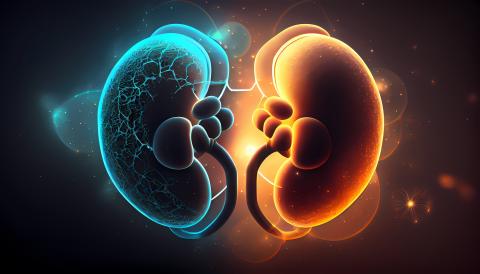First pig-to-human liver transplant evaluated
In 2024, a team of researchers in China transplanted a pig's liver for the first time, with six genes modified to prevent rejection, into a person who was brain dead. After 10 days, they evaluated the condition of the organ and the recipient. According to the authors, who are now publishing the work in the journal Nature, the results suggest that genetically modified pig livers can survive and function in humans, which could serve as a bridge therapy for patients with liver failure who are waiting for human donors.

Beatriz Domínguez - trasplante hígado cerdo EN
Beatriz Domínguez-Gil
Director of the National Transplant Organisation
The study is very well designed and is an extraordinary contribution to the clinical development of xenotransplantation which, in recent years, has advanced dramatically thanks to the generation of transgenic pigs and tested in two different models: in brain-dead people and in patients with a therapeutic objective, usually in the context of compassionate use authorisations.
The main novelty is the use of a portion of liver from a pig with six genetic modifications to perform an auxiliary liver transplant. The person in whom the liver is implanted does not have liver failure, nor is he/she in need of a liver transplant, but with this model they are able to confirm several points. The first is that the graft is functioning properly. Secondly, that the vessels remain intact and that no thrombotic phenomena occur. Finally, that there is no graft rejection.
However, the authors also recognise that the functioning of the organ would not be sufficient for it to be a destination therapy, but they do consider it to be a proof of concept of this idea of auxiliary liver transplantation, which would consist of using this procedure in people with fulminant liver failure for sufficient time to support them until a suitable human organ is identified for transplantation or until the function of the damaged liver recovers spontaneously.
Rafael Matesanz - higado cerdo EN
Rafael Matesanz
Creator and founder of the National Transplant Organisation.
A frequent approach in the development of xenotransplants of different organs, before moving on to the clinical phase, is to perform them in patients in brain death but with haemodynamic stability, so that the evolution of the organ and the impact on the deceased person's body can be assessed, at least in the short term, but with maintained circulation.
In the United States, at least three kidney transplants have been carried out since 2021 —one with up to 61 days of follow-up in people in brain death— and another two heart transplants, which provided a wealth of useful lessons. In both cases, these preceded the first clinical experiences on living persons, which so far have resulted in two heart transplants (both deceased) and four kidney transplants, of which two patients are still alive after several months.
The team at the Military Hospital in Xi'an, China, has had extensive experience in experimental transplantation of all kinds of organs from pigs to monkeys for more than a decade. On this occasion it is the first case in the world of a transplant of a genetically modified pig liver to a human in a brain dead situation. The ultimate aim of the experiment was not to achieve a standard liver transplant, but rather to serve as a ‘bridge organ’ in cases of acute liver failure, while waiting for a human organ that could be used for the definitive transplant. The experiment lasted 10 days and the pig organ remained in good condition, with acceptable basic metabolic function and no signs of acute rejection, indicating that the procedure was satisfactory for the intended purposes and could be used in vivo in the near future.
In Spain, the team at the Virgen de la Arrixaca Hospital in Murcia has also had experience in transplanting pig livers into monkeys since the last century and is preparing a clinical trial, still pending the corresponding approvals, to transplant genetically modified pig livers from the University of Munich to three patients in acute liver failure. The procedure would be carried out on patients with a poor clinical prognosis and in those in whom the organ to be transplanted did not appear within two days, keeping the porcine organ until the patient stabilised and a suitable human liver became available.
The situation of acute liver failure, either due to toxins or an indication for retransplantation in the first days after surgery, occurred in Spain on 111 occasions during 2024, of which a suitable liver was not found in time in 8 cases (7.2%), out of a total of 1,344 transplants. The waiting time for emergency patients was less than 48 hours in 84% of cases and between two and four days in a further 10%. This means that the situation that this type of transplant is intended to treat is not a frequent one in our country, although it cannot be said to be exceptional either. It should be borne in mind that on average there are seven organ donations a day in Spain and a patient with acute liver failure has absolute national priority until a suitable liver is found for them. Needless to say, this is not the situation in most of the world, where having this therapeutic option for certain patients with a poor prognosis can be very useful if it is finally proven possible.
In short, this is an important experiment, which opens up a different path to the one tried so far for both vital organs (heart) and non-vital organs (kidney), such as the temporary replacement of the diseased liver until a human one is obtained for the definitive transplant.
Iván Fernández Vega - higado cerdo EN
Iván Fernández Vega
Full professor of Pathological Anatomy at the University of Oviedo, Scientific Director of the Principality of Asturias Biobank (BioPA) and Coordinator of the Organoid hub of the ISCIII Biomodels and Biobanks platform
I thought it was a very important piece of work, but we have to be cautious. The study represents a milestone in the history of liver xenotransplantation, as it is the first time that a transplant of a genetically modified pig liver into a human being (in this case, a brain-dead patient) has been described.
The quality of the work is very high, both in terms of scientific rigour and the exhaustive clinical, immunological, histological and haemodynamic characterisation of the procedure. Sophisticated genetic modifications have been applied to the graft to prevent hyperacute rejection, one of the most critical complications in preclinical xenotransplantation models.
The clinical implications are highly relevant, as optimising this approach could expand the pool of available organs and save lives in liver emergencies. This work complements and expands the existing evidence on previous xenotransplants of pig hearts and kidneys into humans. It contributes several relevant new findings:
- It is the first study to demonstrate that a genetically modified porcine liver can survive and carry out basic metabolic functions (production of albumin and bile) in the human body.
- It shows that there was no significant coagulation dysfunction, in contrast to what was observed in other models, such as the first human cardiac xenotransplant, where microthrombi and severe disorders were detected.
- It highlights the need to assess possible myocardial damage in the early stages of the postoperative period, given the early elevation of the AST enzyme and cardiac enzymes, something that can be confused with liver damage.
- The use of xenografts as a bridging therapy is proposed, especially in patients with acute liver failure awaiting a human graft, although not as a definitive solution, since bile and albumin production was limited for long-term support.
However, the study has significant limitations:
- An important limitation of the study is that it is a single case (n=1), which prevents generalisable conclusions from being drawn or solid patterns of clinical and immunological response from being established. Although this is a pioneering advance, studies with a larger sample and in living recipients will be necessary to confirm the safety, efficacy and reproducibility of the procedure.
- Limited duration of follow-up (10 days), by decision of the recipient's family, which prevents the viability of the graft from being assessed in the medium and long term. Therefore, it does not add information in relation to acute and chronic rejection of xenotransplants.
- Only basic liver functions were evaluated (albumin synthesis and bile secretion), with no data on other complex liver functions such as drug metabolism, detoxification or immunological function.
- The heterotopic auxiliary transplant procedure would not allow the original liver to be resected, which invalidates it as a strategy for example in patients with hepatocellular carcinoma awaiting transplant.
Kai-Shan Tao et al.
- Research article
- Peer reviewed
- Animals
- People



